 ?Mathematical formulae have been encoded as MathML and are displayed in this HTML version using MathJax in order to improve their display. Uncheck the box to turn MathJax off. This feature requires Javascript. Click on a formula to zoom.
?Mathematical formulae have been encoded as MathML and are displayed in this HTML version using MathJax in order to improve their display. Uncheck the box to turn MathJax off. This feature requires Javascript. Click on a formula to zoom.Abstract
We report on the growth of stoichiometric single crystals, which allow us to unveil their intrinsic magnetic properties. The effect of different growth conditions has been investigated for crystals grown by the flux method. We find that the magnetic response depends very sensitively on the details of the growth conditions. We assess the defect concentration based on magnetization, X-ray diffraction, Raman scattering, and optical conductivity measurements. We find that samples with a low concentration of electronically active defects show much reduced in-gap spectral weight in the optical conductivity and a pronounced two-magnon peak in the Raman scattering spectrum. A prolonged exposure at high temperature during the growth leads to higher defect concentration likely due to creation of oxygen vacancies. We further demonstrate a systematic intergrowth of
and
phases by varying the growth temperature. Our results thus emphasize that revealing the intrinsic magnetic properties of
and related materials requires a scrupulous control of the crystal growth process.
1. Introduction
The interest in iridates grows fuelled by the prospect of discovering novel electronic and/or topological orders that emerge from the interplay of spin–orbit coupling and electron correlations. is an archetypal example of such new phases, exhibiting a Mott gap and a distinct spin–orbital entangled magnetic structure [Citation1,Citation2]. Although
has been studied since the early 1990s in connection to high- temperature superconducting cuprates [Citation3,Citation4], the important role of spin–orbit coupling had not been appreciated then. From recent studies of electronic and magnetic excitation spectra, it is now well understood that the insulating nature of
is due to strong spin–orbit coupling [Citation1], suppression of which results in a metallic phase in
[Citation5], a 4d counterpart of
.
The magnetic structure and dynamics of are now reasonably well understood within the theoretical framework in the strong spin–orbit coupling limit described in terms of the
/2 Kramers doublet. Remarkably, the
/2 isospins allow rich expressions of magnetic coupling depending on the lattice and bonding geometry, ranging from isotropic Heisenberg interaction to a bond-directional, Ising-like interaction [Citation6]. The latter provides a basis for implementing exotic quantum magnets inspired by the Kitaev model [Citation7]. The former surprisingly indicates that a system with very strong spin–orbit coupling can mimic a system without it. Experimentally, it has been confirmed that the canted antiferromagnetic structure of
derives from a predominantly isotropic nearest neighbour magnetic exchange coupling [Citation8–Citation10]. Thus,
becomes the first non-cuprate material to realize a (iso)spin-1/2 Heisenberg antiferromagnet in a quasi-two-dimensional square lattice – a possible platform for high temperature superconductivity [Citation11–Citation15].
Most recently, tantalizing indications of d-wave superconductivity have been seen in electron-doped [Citation16,Citation17]: a gap of predominantly d-wave symmetry is observed in the low-temperature angle-resolved photoemission spectra [Citation16], and a particle-hole symmetric density of states is observed in scanning tunnelling spectra below a temperature as high as 50 K [Citation17]. Above this temperature, the d-wave gap evolves into a pseudogap, in striking parallel with the cuprates [Citation12,Citation16]. However, because of the inherently surface sensitive nature of the technique used to dope the sample in these studies, involving in situ deposition of alkali metal atoms on the surface of undoped
, it remains unclear at this point whether the d-wave gap originates from superconductivity without evidence from bulk measurements. At least, these results indicate that highly non-trivial electronic phases emerge from doping a ‘spin–orbit’ Mott insulator.
The more traditional method of chemical doping [Citation18–Citation20] through, for example, substitution of Sr by La, has proven to be much more difficult than in cuprates. La-doped single crystals have only become available in the last couple of years [Citation21–Citation23], but angle-resolved photoemission studies on them [Citation21,Citation22] do not fully reproduce the observations made via the in situ doping method [Citation12,Citation16]. While it is unclear at the moment what leads to such differences between the two doping methods, we note that a well-defined quasi-particle peak is absent for any doping level in La-doped samples, indicating suppressed coherent motion of doped electrons presumably due to disorder created by chemical doping.
Moreover, we note that previous studies on the parent and its sister compounds have shown significant variations in the magnetic properties even without doping, likely reflecting different defect concentrations [Citation2,Citation4,Citation18,Citation22,Citation29]. For example, the sizable c-axis component of the uniform magnetic susceptibility is not understood and seems incompatible with the known magnetic structure of
. In addition, the diamagnetism initially reported for
is completely unexplained and is absent in samples grown under different conditions [Citation27–Citation29]. Therefore, we believe it is imperative to establish the intrinsic magnetic properties through growth of stoichiometric single crystals of the parent iridates before the doping-induced phenomena can be fully explored.
In this paper, we describe the synthesis and characterization of single crystals. Synthesis of stoichiometric single crystals was achieved using the flux method, and characterizations were performed using magnetization, X-ray diffraction, Raman scattering, and optical conductivity measurements. We find that the magnetic response depends very sensitively on subtle details of the growth condition. Through energy-dispersive X-ray spectroscopy (EDX), optical spectroscopy, and Raman scattering, we infer that oxygen vacancies are the likely culprit of the divergent properties reported for
. Furthermore, by systematic variation of the growth temperature, we are able to introduce, in a controlled way, layers of
into the bulk
single crystals. Our results thus emphasize that revealing the intrinsic magnetic properties of
and related materials requires careful attention to the oxygen stoichiometry.
2. Experimental details
Single crystals were grown using flux method. Powders of , and
were thoroughly mixed and placed in a platinum crucible covered with a lid. The crucibles were heated in a programmable box furnace in air then cooled to room temperature and removed from the furnace. The details of the growth conditions are documented in Tables –. After cooling, crystals were separated from the residual flux by rinsing out with distilled water. The crystals were found to have a regular shape with a large flat shiny surface with lengths up to few mm. The characterizations of crystals were performed using powder X-ray diffraction (XRD) in Debye–Scherrer geometry with Ag-K
1 radiation, single crystal XRD in a high-resolution four-circle diffractometer with Cu-K
1 radiation, as well as energy dispersive EDX equipped with a scanning electron microscope. The magnetization measurements were carried out using a commercial superconducting quantum interference device magnetometer (MPMS SQUID VSM, Quantum Design). The low-temperature Raman scattering experiments were performed in the backscattering geometry using a Jobin Yvon LabRam HR800 spectrometer and the 632.8 nm excitation line of a He–Ne laser was used. The power of the laser beam was 1.5 mW and the diameter of the beam
. The samples were cooled down in a He flow cryostat. To describe the scattering geometries, we use the Porto notation A(BC)A
, where A(B) and A
(C) stand for the propagation (polarization) directions of the incident and scattered light relative to the crystalline axes. All of the data presented in this paper were taken with the light propagation direction along the crystalline c-axis; hence only the polarization orientations will be specified. Crystals were cleaved ex situ to obtain a fresh clean surface. The far infrared (FIR) ellipsometric measurements were carried out on a home-built ellipsometer attached to a Bruker 66v/S FT-IR spectrometer located at the IR1 beamline of the ANKA synchrotron at KIT, Germany. The experiments were performed on the same samples as used for the Raman spectroscopy studies. The complex optical conductivity
is obtained from the ellipsometric angles
and
by direct inversion of the Fresnel formulae.
3. Result and discussion
We start by looking at the magnetic properties of four single crystals (labelled Sr214
through
) grown from the same molar ratio of starting materials under varying heating sequences as described in Table . The biggest difference in the growth condition is between Sr214
and Sr214
. While both start from heating the starting materials up to 1300
C, Sr214
is exposed to elevated temperatures for a longer time. The growth sequence of Sr214
and Sr214
are modifications of Sr214
and Sr214
, respectively. Note that our growth is performed in much lower temperature ranges than used in most of the earlier works [Citation23,Citation28,Citation30]. In Figure (a), we plot the temperature dependence of the magnetization M(T) of each crystal measured in a magnetic field of 5 kOe applied perpendicular to the crystallographic c-axis (H
ab), well above the metamagnetic transition that occurs at
2 kOe (see inset of Figure (a)). Above this field, canted moments that result from rotation of oxygen octahedra stack ferromagnetically along the c-direction, and the uniform susceptibility looks similar to that of a ferromagnet. Comparison of different curves shows that the highest saturated magnetic moment is achieved for Sr214
(M = 0.98 emu/g and
at T = 5 K, H = 5 kOe). Other batches show significantly lower values ranging between 0.82 and 0.92 emu/g. Further, a ‘two-step’ structure in the M(T) curve is noticed for Sr214
, and a slight decrease in the magnetization is observed at low temperature below
30 K for Sr214
. In the inset of Figure (a), we plot the isothermal magnetization M(H) curve of all samples. In Sr214
the metamagnetic transition is much sharper compared to the other three crystals.
Table 1. Synthesis conditions for crystals with fixed molar ratio of starting materials and various synthesis sequences.
Table 2. Synthesis conditions for stoichiometric (Sr214
), non-stoichiometric
with oxygen vacancy (Sr214
and
).
Table 3. Synthesis conditions for (Sr214#1),
(Sr327) and intergrowth of
and
(Sr214/Sr327#1, #2, and #3).
Figure 1. (colour online) Temperature dependent magnetization, M(T), of single crystals measured on warming after field-cooling (FCW mode) with an applied field of (a) H = 5 kOe and (b) H = 1 kOe perpendicular to the crystallographic c-axis (H
ab). The inset of (a) displays isothermal magnetization M(H) of
single crystals at T = 5 K (H
ab) and the inset of (b) shows expended plot of M(T) at low temperatures for Sr214
.
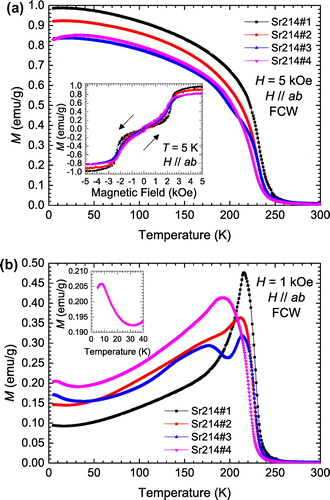
These differences in the M(T) curves (Figure (a)) are more prominent in measurements performed in applied field below the metamagnetic critical field at H = 1 kOe, shown in Figure (b). Whereas, Sr214 with the highest saturated moment shows a sharp peak at T = 215 K, Sr214
shows a broad hump peaked at a much lower temperature T = 175 K. Two anomalies are found in Sr214
and Sr214
, suggesting coexistence of the two features seen in Sr214
and Sr214
. It is noteworthy that previously published results share more resemblance to the broad profile of Sr214
rather than the sharp profile of Sr214
[Citation18,Citation25]. Sr214
shows another anomaly in the low temperature region (inset of Figure (b)) similar to earlier data, based on which a transition to a different magnetic structure, possibly a non-coplanar structure that has a c-axis component, has been suggested [Citation18,Citation25]. However, these anomalies are clearly absent in Sr214
. Furthermore, we observe almost zero c-axis magnetic susceptibility (Figure ), in sharp contrast to earlier studies that report a sizable c-axis response [Citation18,Citation24,Citation25].
Figure 2. (colour online) Temperature dependence of magnetization M(T) of a single crystal (Sr214
) in ZFC and FCW modes at H = 5 kOe with H
ab and H
c, respectively. Inset: Isothermal magnetization M(H) at T = 5 K with H
ab and H
c, respectively.
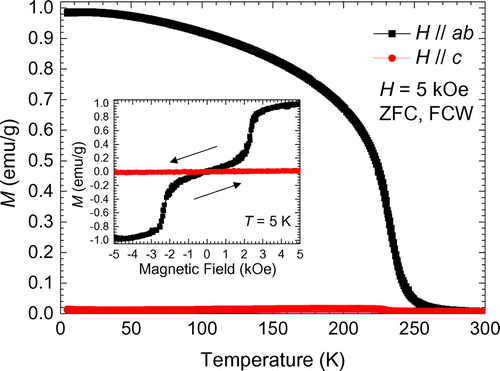
Our measurements highlight the strong dependence of the magnetic properties of to subtle differences in the growth condition. As we shall see later on, we judge based on optical conductivity and Raman scattering spectra that Sr214
has the lowest defect concentration among all crystals we have grown. Therefore, we believe that the magnetic behaviour reported above for Sr214
is representative of the clean, ideal phase of
.
Given that samples that were exposed to high temperature for longer time have lower sample quality, we further investigated the effect of prolonged exposure at 1300 C (Sr214
, see Table ). This sample showed significantly reduced magnetic ordering temperature, and a down turn in the M(T) curve below
50 K. Most of the earlier data on
show such down turn in the M(T) curve [Citation18,Citation25]. Our EDX measurements indicate that Sr214
is deficient in oxygen (see Table ). Although EDX is not very sensitive to oxygen, the difference in the oxygen content from Sr214
is statistically significant. A similar magnetic behaviour is observed in a sample (Sr214
) grown using the same heating sequence as in Sr214
but with 10% less molar ratio of
. This further indicates that the different magnetic behaviour is due to a non-stoichiometry in the sample, also supported by the EDX measurement of Sr214
showing further deviation from the ideal stoichiometry (Table ). In Figure (a), we plot the M(T) curves measured on zero field cooling (ZFC) and on field cooled warming (FCW) modes at H = 5 kOe. Both Sr214
and Sr214
show substantial decrease in the magnetic moment and the transition temperatures (
). Further, Sr214
shows glassy behaviour at low temperature. In Figure (b), we plot the inverse of the ZFC data to highlight the change in transition temperature from T
240 K to T
200 K. For Sr214
and Sr214
, M(H) curves show hysteresis, which is absent in Sr214
(Figure (c)).
Figure 3. (colour online) (a) Temperature dependence of magnetization M(T) for Sr214, Sr214
, and Sr214
at H = 5 kOe with H
ab in ZFC and FCW modes. (b) Inverse magnetic moments around
. (c) Magnetic field-dependent magnetizations M(H) for Sr214
, Sr214
, and Sr214
at T = 5 K with applied field perpendicular to the c-axis (H
ab). Inset: expanded plot of M(H) for Sr214
.
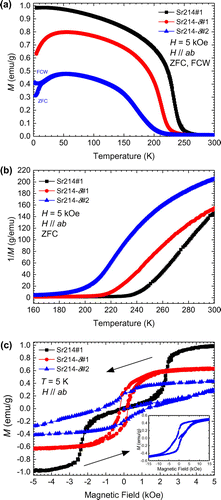
We now look for structural distortions associated with the oxygen vacancies. Single crystal XRD experiments on Sr214 and Sr214
reveal an increase in the mosaicity of the non-stoichiometric sample as seen in the width of the rocking curve through the (0,0,4) Bragg reflection (Figure (c)), pointing to decreased structural quality. Nevertheless, neither powder nor single crystal XRD resolve a systematic change in the lattice parameters or atomic positions, as seen in the nearly identical powder patterns in Figure (a) and (b). Since X-rays are rather insensitive to oxygen atoms, we investigated the nature of this distortion by looking at the lattice dynamics using low-temperature Raman spectroscopy.
Figure 4. (colour online) X-ray powder diffraction pattern for (a) Sr214 and (b) Sr214
taken in Debye–Scherrer geometry using a 0.3 mm diameter capillary. (c) Rocking curve through (0,0,4) reflection for single crystals of Sr214
and Sr214
.
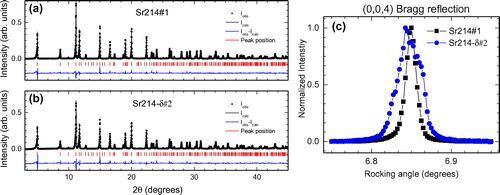
Previous Raman results on and
have observed that the 34 meV
phonon mode, associated with in-plane bending of the Ir–O–Ir bonds, is extremely sensitive to structural distortions [Citation31,Citation32]. An additional phonon mode was for instance found in the vicinity of this mode in
due to the formation of two Ir(Ru)–O–Ir(Ru) bond angles, indicating a phase separation [Citation32]. We therefore look for signature of structural distortions in Sr214
, Sr214
, and Sr214
by measuring their 34 meV in-plane bending mode with Raman scattering.
In Figure (a), we show the low-energy Raman spectra of Sr214, Sr214
, and Sr214
taken at T = 20 K using the XX-channel probing modes with
and
symmetry. Three
phonon modes are observed in the presented energy range for Sr214
, the aforementioned 34 meV mode along with two smaller modes around 42 meV. This is in good agreement with previous findings [Citation31]. For Sr214
and Sr214
, an additional Raman-active mode becomes visible around 32 meV, while the two modes around 42 meV vanish and the 34 meV mode broadens and shifts to lower energy. This result is indicative of distorted in-plane Ir–O–Ir angle (
) [Citation32], most likely originating from in-plane oxygen vacancies. In Figure (b), we show the high-energy Raman spectra of the same samples taken T = 20 K using the XY-channel (
). In this geometry the two-magnon signal can be observed [Citation33]. The two-magnon signal, found around 160 meV, becomes weaker and broader in Sr214
and Sr214
. These Raman results consistently indicate that oxygen vacancies lead to the observable difference in the magnetization data between Sr214
and other samples.
Figure 5. (colour online) (a) Low-energy Raman spectra of Sr214, Sr214
, and Sr214
taken at T = 20 K using the XX-channel (
and
). (b) High-energy Raman spectra taken T = 20 K using the XY-channel (
) [Citation33] and (c) real part of the FIR optical conductivity
at
of the same samples.
![Figure 5. (colour online) (a) Low-energy Raman spectra of Sr214#1, Sr214-δ #1, and Sr214-δ #2 taken at T = 20 K using the XX-channel (A1g and B1g). (b) High-energy Raman spectra taken T = 20 K using the XY-channel (B2g) [Citation33] and (c) real part of the FIR optical conductivity σ1(ω) at T=7K of the same samples.](/cms/asset/5649caa9-10d3-4c7f-8a00-1e61ff51e5f2/tphm_a_1134835_f0005_oc.gif)
We now investigate the effect of oxygen vacancies on the infrared (IR)-active phonons and the in-gap spectral weight. Figure (c) shows the real part of the optical conductivity in the far-IR spectral range. Compared to the clean sample Sr214#1, both oxygen-deficient samples show a significant increase in the background level of the optical conductivity
. We attribute this rise in absorption to an increased number of defect states due to oxygen vacancies. While the phonon line shapes of sample Sr214-
#2 are rather similar to the clean case with just a small increase in the peak width, the sample Sr214-
#1 shows a remarkable difference. The phonon at
experiences a significant energy shift to
, whereas the one centred at
softens to
and its intensity strongly decreases. These two phonons have been assigned to in-plane bending modes of the
oxygen octahedra [Citation34]. This suggests even stronger in-plane distortions of the oxygen octahedra in the Sr214-
#1 sample although the overall background level of absorption appears to be smaller compared to Sr214-
#2.
We now move on to demonstrate that layers, or slabs, of can be introduced into a single crystal of
by further altering the growth sequence. In Table , the growth sequence and molar starting ratio of parent
and its sister compound,
single crystals, can be seen. We have confirmed the quality of our parent
single crystals by measuring the magnetic susceptibility. In Figure , we plot M(T) for
in FCW mode with applied field being perpendicular to the c-axis (H
ab). Three different fields were used, H = 10 Oe, 1 kOe, and 5 kOe. In all measurements, a magnetic phase transition is observed at
K. At lower temperatures, no other transition is seen in contrast to previous results [Citation28,Citation29].
Figure 6. (colour online) Temperature dependence of magnetization for a single crystal in FCW mode with applied field perpendicular to the c-axis (H
ab) at H = 10 Oe, 1 kOe, and 5 kOe.
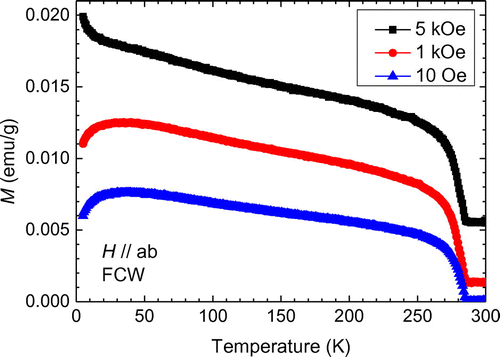
One can notice that in order to produce pure single crystals, the starting temperature of the growth sequence for Sr214
has to be substantially reduced, along with a change in the molar ratio. Therefore, one way to induce intergrowth of
and
would be to systematically reduce the starting temperature of the growth sequence for Sr214
, from 1300 to 1050
C, while at the same time keep the molar starting ratio unchanged. This approach is displayed in Table , where we present in details the growth sequence for the intergrowth of
and
samples (Sr214/Sr327
,
, and
).
Figure 7. (colour online) Temperature dependence of magnetization M(T) at H = 5 kOe (H
ab) for
(Sr214
),
(Sr327) and intergrowth samples (Sr214/327
,
and
).
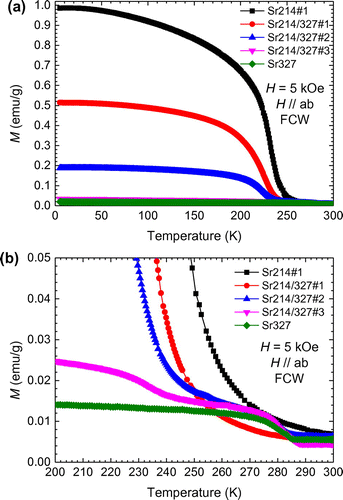
Figure 8. (colour online) Single crystal X-ray diffraction pattern of the (0,0,L) reflections for a crystal grown using similar conditions to Sr214/Sr327. Peaks identified with the periodicities of
and
are denoted by vertical lines. Small peaks in the background are not related to impurity phases, as they disappear upon rocking the sample. Rather, their positions are consistent with stacking faults of the form SSD, SDD, and SSDD where S and D denote single and bilayer respectively.

In Figure (a), we plot the temperature dependence of the magnetization M(T) of each crystal in Table with H
ab. Comparison of different curves reveals that by lowering the starting temperature of the growth sequence the saturated magnetic moment gradually approaches the value measured for pure
. Interestingly, in Figure (b), where we show a closer look at the onset of magnetic order, one can notice a two-step structure in the M(T) curve of Sr214/Sr327
and
. Comparison to pure
reveals that the transtion at
K is associated with the
portion of the intergrowth samples, while the stronger transition
K comes from the
part. Moreover, by looking at the saturated magnetic moments in M(T) (see Figure (a)), the ratio of the two phases can be estimated;
has a saturation magnetic moment of
1 emu/g while in comparison, in
the magnetic moment at H = 5 kOe is negligible (H
ab). Using this method we can control, by varying the synthesis conditions (Table ), the proportion of the two phases. The
contribution to Sr214/Sr327
is about 0.5, while this ratio drops to about 0.2 in Sr214/Sr327
and around 0.03 in Sr214/Sr327
. Given the difference in the c-axis lattice parameter, the intergrowth nature of these samples is confirmed using single crystal XRD to study the Bragg reflections along L. As seen in Figure , reflections corresponding to
or
can be observed in the same single crystal.
4. Conclusion
We have investigated the relationship between different synthesis conditions and magnetic properties in single crystals. Depending on the synthesis condition, we observe varying magnetic properties most likely due to oxygen vacancies. For off-stoichiometric samples, additional phonon modes appear in Raman scattering spectra due to structural distortions and in-gap states appear in optical conductivity measurements. Consistent with the magnetization measurements, we find that the two-magnon Raman peak broadens, signalling weaker magnetic correlations in these distorted samples. In addition, we have shown that intergrowth of the
phase into
single crystals can be controlled by varying the synthesis conditions. Our results therefore emphasizes that revealing the intrinsic physical properties of
and related materials require scrupulous control of the synthesis conditions.
Additional information
Funding
Notes
No potential conflict of interest was reported by the authors.
References
- B.J. Kim , H. Jin , S.J. Moon , J.-Y. Kim , B.-G. Park , C.S. Leem , J. Yu , T. W. Noh , C. Kim , S.-J. Oh , J.-H. Park , V. Durairaj , G. Cao , and E. Rotenberg , Novel Jeff=1/2 mott state induced by relativistic spin-orbit coupling in Sr2IrO4 , Phys. Rev. Lett. 101 (2008), pp. 076402-1–076402-4.
- B.J. Kim , H. Ohsumi , T. Komesu , S. Sakai , T. Morita , H. Takagi , and T. Arima , Phase-sensitive observation of a spin-orbital mott state in Sr2IrO4 , Science 323 (2009), pp. 1329–1332, and supporting material therein.
- R.J. Cava , B. Batlogg , K. Kiyono , H. Takagi , J.J. Krajewski , W.F. Peck Jr., L.W. Rupp Jr ., and C.H. Chen , Localized-to-itinerant electron transition in Sr2IrO1-xRuxO4 , Phys. Rev. B 49 (1994), pp. 11890–11894.
- M.K. Crawford , M.A. Subramanian , R.L. Harlow , J.A. Fernandez-Baca , Z.R. Wang , and D.C. Johnston , Structural and magnetic studies of Sr2IrO4 , Phys. Rev. B 49 (1994), pp. 9198–9201.
- T.F. Qi , O.B. Korneta , L. Li , K. Butrouna , V.S. Cao , X. Wan , P. Schlottmann , R.K. Kaul , and G. Cao , Spin-orbit tuned metal-insulator transitions in single-crystal Sr2IrO1-xRuxO4, Phys. Rev. B 86 (2012), pp. 125105-1–125105-6.
- G. Jackeli and G. Khaliullin , Mott insulators in the strong spin-orbit coupling limit: from heisenberg to a quantum compass and kitaev models, Phys. Rev. Lett. 102 (2009), pp. 017205-1–017205-4.
- A. Kitaev , Anyons in an exactly solved model and beyond, Phys. 321 (2006), pp. 2–111.
- J. Kim , D. Casa , M.H. Upton , T. Gog , Y.-J. Kim , J.F. Mitchell , M. van Veenendaal , M. Daghofer , J. van den Brink , G. Khaliullin , and B.J. Kim , Magnetic excitation spectra of Sr2IrO4 probed by resonant inelastic X-Ray scattering: establishing links to cuprate superconductors, Phys. Rev. Lett. 108 (2012), pp. 177003-1–177003-5.
- S. Fujiyama , H. Ohsumi , T. Komesu , J. Matsuno , B.J. Kim , M. Takata , T. Arima , and H. Takagi , Two-dimensional heisenberg behavior of Jeff = 1/2 isospins in the paramagnetic state of the spin-orbital mott insulator Sr2IrO4, Phys. Rev. Lett. 108 (2012), pp. 247212-1–247212-5.
- J.G. Vale , S. Boseggia , H.C. Walker , R. Springell , Z. Feng , E.C. Hunter , R.S. Perry , D. Prabhakaran , A.T. Boothroyd , S.P. Collins , H.M. Ronow , and D.F. McMorrow , Importance of XY anisotropy in Sr2IrO4 revealed by magnetic critical scattering experiments, Phys. Rev. B 92 (2015), pp. 020406(R)-1–020406(R)-5.
- J. Kim , M. Daghofer , A.H. Said , T. Gog , J. van den Brink , G. Khaliullin , and B.J. Kim , Excitonic quasiparticles in a spin-orbit Mott insulator, Nat. Commun. 5 (2014), pp. 4453
- Y.K. Kim , O. Krupin , J.D. Denlinger , A. Bostwick , E. Rotenberg , Q. Zhao , J.F. Mitchell , J.W. Allen , and B.J. Kim , Fermi arcs in a doped pseudospin-1/2 Heisenberg antiferromagnet, Science 345 (2014), pp. 187–190.
- F. Wang and T. Senthil , Twisted hubbard model for Sr2IrO4: magnetism and possible high temperature superconductivity, Phys. Rev. Lett. 106 (2011), pp. 136402-1–136402-4.
- Y. Yang , W.-S. Wang , J.-G. Liu , H. Chen , J.-H. Dai , and Q.-H. Wang , Superconductivity in doped Sr2IrO4: a functional renormalization group study, Phys. Rev. B 89 (2014), pp. 094518-1–094518-5.
- Z.Y. Meng , Y.B. Kim , and H.-Y. Kee , Odd-parity triplet superconducting phase in multiorbital materials with a strong spin-orbit coupling: application to doped Sr2IrO4, Phys. Rev. Lett. 113 (2014), pp. 177003-1–177003-5.
- Y.K. Kim , N.H. Sung , J.D. Denlinger , and B.J. Kim , Observation of a d-wave gap in electron-doped Sr2IrO4, Nat. Phys. 12 (2016), pp. 37–41.
- Y.J. Yan , M.Q. Ren , H.C. Xu , B.P. Xie , R. Tao , H.Y. Choi , N. Lee , Y.J. Choi , T. Zhang , and D.L. Feng , Electron-doped Sr2IrO4: an analogue of hole-doped cuprate superconductors demonstrated by scanning tunneling microscopy, , 5Phys. Rev. X (2015), pp. 04108-1–04108-7.
- M. Ge , T.F. Qi , O.B. Korneta , D.E. De Long , P. Schlottmann , W.P. Crummett , and G. Cao , Lattice-driven magnetoresistivity and metal-insulator transition in single-layered iridates, Phys. Rev. B 84 (2011), pp. 100402(R)-1–100402(R)-5.
- O.B. Korneta , T. Qi , S. Chikara , S. Parkin , L.E. De Long , P. Schlottmann , and G. Cao , Electron-doped Sr2IrO4: evolution of a disordered Sr2IrO4 mott insulator into an exotic metallic state, Phys. Rev. B 82 (2010), pp. 115117-1–115117-5. Available at http://journals.aps.org/prb/abstract/10.1103/PhysRevB.82.115117
- T.F. Qi , O.B. Korneta , S. Chikara , M. Ge , S. Parkin , L.E. De Long , P. Schlottmann , and G. Cao , Electron doped Sr2IrO4: Evolution of a disordered Jeff =1/2 Mott insulator into an exotic metallic state, J. Appl. Phys. 109 (2011), pp. 07D906-1–07D906-3. Available at http://scitation.aip.org/content/aip/journal/jap/109/7/10.1063/1.3545803
- A. de la Torre , S. McKeown Walker , F.Y. Bruno , S. Ricco , Z. Wang , I. Gutierrez Lezama , G. Scheerer , G. Giriat , D. Jaccard , C. Berthod , T.K. Kim , M. Hoesch , E.C. Hunter , R.S. Perry , A. Tamai , and F. Baumberger , Collapse of the mott gap and emergence of a nodal liquid in lightly doped Sr2IrO4, Phys. Rev. Lett. 115 (2015), pp. 176402-1–176402-5.
- V. Brouet , J. Mansart , L. Perfetti , C. Piovera , I. Vobornik , P. Le Fevre , F. Bertran , S.C. Riggs , M.C. Shapiro , P. Giraldo-Gallo , and I.R. Fisher , Transfer of spectral weight across the gap of Sr2IrO4 induced by La doping, Phys. Rev. B 92 (2015), pp. 081117(R)-1–081117(R)-5.
- Xiang Chen , Tom Hogan , D. Walkup , W. Zhou , M. Pokharel , M. Yao , W. Tian , T.Z. Ward , Y. Zhao , D. Parshall , C. Opeil , J.W. Lynn , Vidya Madhavan , and S.D. Wilson , Influence of electron doping on the ground state of Sr2IrO4, Phys. Rev. B 92 (2015), pp. 075125-1–075125-11.
- G. Cao , J. Bolivar , S. McCall , J.E. Crow , and R.P. Guertin , Weak ferromagnetism, metal-to-nonmetal transition, and negative differential resistivity in single-crystal Sr2IrO4, Phys. Rev. B 57 (1998), pp. R11039.
- S. Chikara , O. Korneta , W.P. Crummett , L.E. DeLong , P. Schlottmann , and G. Cao , Giant magnetoelectric effect in the Jeff =1/2 Mott insulator Sr2IrO4, Phys. Rev. B 80 (2009) p.140407(R)-1–140407(R)-4. Available at http://journals.aps.org/prb/abstract/10.1103/PhysRevB.80.140407.
- S. Chikara , O. Korneta , W.P. Crummett , L.E. DeLong , P. Schlottmann , and G. Cao , Giant magnetoelectric effect in the Jeff =1/2 Mott insulator Sr2IrO4, J. Appl. Phys. 107 (2010), pp. 09D910-1–09D910-3. Available at http://scitation.aip.org/content/aip/journal/jap/107/9/10.1063/1.3362912
- M. Miyazaki , R. Kadono , M. Hiraishi , A. Koda , K.M. Kojima , K. Ohashi , T. Takayama , and H. Takagi , Evidence for ordered magnetic moments at oxygen sites in antiferromagnetic Sr2IrO4 and Sr2IrO4, Phys. Rev. B 91 (2015), pp. 155113-1–155113-11.
- S. Boseggia , R. Springell , H.C. Walker , A.T. Boothroyd , D. Prabhakaran , D. Wermeille , L. Bouchenoire , S.P. Collins , and D.F. McMorrow , Antiferromagnetic order and domains in Sr2IrO4 probed by x-ray resonant scattering, Phys. Rev. B 85 (2012), pp. 184432-1–184432-8.
- G. Cao , Y. Xin , C.S. Alexander , J.E. Crow , P. Schlottmann , M.K. Crawford , R.L. Harlow , and W. Marshall , Anomalous magnetic and transport behavior in the magnetic insulator Sr2IrO4, Phys. Rev. B 66 (2002), pp. 214412-1–214412-7.
- I. Franke , P.J. Baker , S.J. Blundell , T. Lancaster , W. Hayes , F.L. Pratt , and G. Cao , Measurement of the internal magnetic field in the correlated iridates Ca4IrO6, Ca5Ir3O12, Sr3Ir2O7 and Sr2IrO4, Phys. Rev. B 83 (2011), pp. 094416-1–094416-5.
- M.F. Cetin , P. Lemmens , V. Gnezdilov , D. Wulferding , D. Menzel , T. Takayama , K. Ohashi , and H. Takagi , Crossover from coherent to incoherent scattering in spin-orbit dominated Sr2IrO4, Phys. Rev. B 85 (2012) p.195148-1–195148-7.
- A. Glamazda , W.-J. Lee , K.-Y. Choi , P. Lemmens , H.Y. Choi , N. Lee , and Y.J. Choi , Effects of hole doping on magnetic and lattice excitations in Sr2IrO4, Phys. Rev. B 89 (2014), pp. 104406-1–104406-7.
- H. Gretarsson , N.H. Sung , M. Hoeppner , B.J. Kim , B. Keimer , and M. Le Tacon , arXiv:1509.03396.
- S.J. Moon , H. Jin , W.S. Choi , J.S. Lee , S.S.A. Seo , J. Yu , G. Cao , T.W. Noh , and Y.S. Lee , Temperature dependence of the electronic structure of the Sr2IrO4=1/2 Mott insulator Sr2IrO4 studied by optical spectroscopy, Phys. Rev. B 80 (2009), pp. 195110-1–195110-5.
